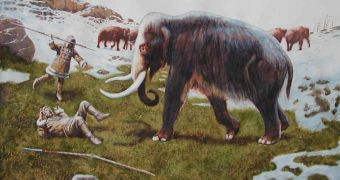By far, this is the most emblematic giant beast of the Ice Age: the woolly mammoth.
Now, a research investigating DNA from the bones, teeth and tusks of the extinct mammoths showed how their populations fluctuated after the last interglacial period, during the last glaciation.
"In combination with the results on other species, a picture is emerging of extinction not as a sudden event at the end of the last ice age, but as a piecemeal process over tens of thousands of years involving progressive loss of genetic diversity," said Dr. Ian Barnes, of Royal Holloway, University of London.
"For the mammoth, this seems much more likely to have been driven by environmental rather than human causes, even if humans might have been responsible for killing off the small, terminal populations that were left."
Barnes, together with a team including Dr. Adrian Lister of the University College London and the Natural History Museum in London, had previously showed that bison, bears and lions experienced major population shifts 25-50,000 years ago.
"Those results came as a surprise, because scientists tended to think that the major environmental changes happened about 15-25,000 years ago, when the glaciers reached their fullest extent," said the researchers.
The new results show that early human hunters were not the main cause of the extinction of these beasts as they emerged in large numbers much later. In the case of the woolly mammoth, the team found an "interesting pattern, not like those of the other species."
The DNA analysis showed that Siberian mammoths expanded from a small base about 60,000 years ago.
The genetic data revealed two distinct genetic groups, thus mammoths remained isolated for some time before merging back into a sole population. By about 40,000 years ago, one of the groups vanished, so that only the second group survived till the mammoth's final extinction.
"At a time when we should be very concerned about the potential extinction of many existing large mammals, studying those that occurred in the geologically recent past can provide many insights. Our work, together with that of others, shows that the conditions for extinction can be set up long before the actual extinction event." said Lister.

 14 DAY TRIAL //
14 DAY TRIAL //